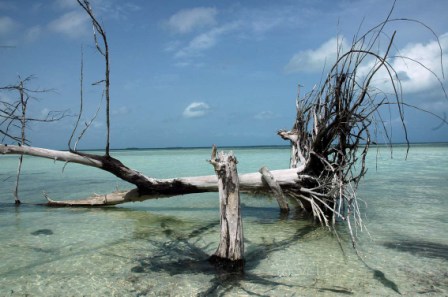Getting Married in Cuba & Something More

HAVANA TIMES, Nov. 4 — “This is like getting married in paradise,” said a young Canadian couple fully dressed for the occasion.
They had just gotten married amid the sand of Cayo Santa Maria, an astonishingly beautiful island of the Cuban archipelago.
When people in Havana told me that last year more than 500 foreign couples had been married on its beaches, I found it difficult to believe. So, I decided to confirm it with my own eyes – something that required hardly any sacrifice.
At the hotel I was told that a veritable nuptial fever had broken out. They believe that this year the figure for marriages will be even greater, citing the fact that on occasion —owing to overbooking or the lack of space— they’ve already had to begin directing couples to other hotels.
But Cayo Santa Maria had other surprises in reserve for me. The most important was the number of Cubans I found there. The manager of the hotel told me there were days during this past summer when there were more national guests than foreigners.
It’s not difficult to distinguish them, and I’m not referring only to physical appearances. The Cuban couples are the ones who kiss passionately in the swimming pools, those who roar with laughter in the restaurants, those who dance salsa the best and who are the principal sources of commotion.
There were Cubans who live in Cuba as well as émigrés, but it wasn’t hard to distinguish between these two groups either; all I had to do was look at the thickness of their gold chains. All of them wore those, but the Cubans from Miami sported chains that were enormous.
It’s true that the hotel no longer enjoys the tranquility and peace that people experienced when nationals were prohibited; on the other hand, however, tourists from other countries now have the chance to meet people from the Cuban mainland.
The managers of the hotel recognize that the repeal of the prohibition was beneficial. “It was difficult to explain the double standard to foreign visitors, and therefore we lost a lot of potential guests. But just imagine, this year we’ve had weekends with 600 Cuban vacationers.”
“But the racket?” I asked. “It’s nothing that can’t be controlled with a simple warning when it gets too loud,” they responded, adding that they’ve had more problems with foreign teenagers than with the national tourists.
I then inquired, “Who are the Cubans that come here?” They explained that they don’t have any accurate figures but that they know that they’re artists, athletes, émigrés, self-employed workers and a large number of people who work at other tourist centers.
But these weren’t the only contacts that foreigners had with the country. In the restaurants one could hear the classics of Cuban and international music played by top-notch bands like Alter Ego, brought in especially from Santa Clara.
In the afternoons a local saxophonist would stroll through the lobby treating us to an impromptu “jam session.” Then too, every morning a Thai Chi teacher came from the town of Caibarien, and at nights we played chess like grandmasters with people from nearby Remedios.
I was pleasantly surprised to find all the staff addressing us with familiarities while at the same time diligently attending to us. They never called me “Mister,” and they constantly entered into conversation with us, especially on topics that were human – even divine.
When I was leaving the hotel, I joked with the room cleaner telling her that I had left my diamond-studded gold watch in the room. She responded —intensely serious— saying, “Then it must still be there, because I’m not going to lose my job and house for anything in the world.”
This was how I found out that the hotel had financed the construction of a neighborhood for its workers in the town of Remedios. The waitress told me that the house was not yet hers, but that “it will be mine when I finish paying off the loan in a few years.”
On my return to Havana, I stopped on the mainland to take a look at those apartments. They’re unmistakable: much more beautiful than the other buildings in the town. They have a distinct design, are painted in more vibrant colors and seem to be better built.
I think that it’s healthy for tourists to meet and know the people of the country they visit. Those who come to Cayo Santa Maria will at least be able to say that Cubans are talkative, full of life, that they dance sensually to their amazing music and that they play pretty damn good chess.
The authorization allowing Cuban citizens into hotels was a wise decision. The prohibition not only violated the constitutional rights of those citizens, it also projected a negative image of the country and deprived it of needed revenue.
Looking at the brilliant white sand and the turquoise blue sea, I understand how tourists feel they’re getting married in paradise. On the other hand, for me the greatest satisfaction was staying in a tourist hotel and feeling —for the first time— that I was still in Cuba.
Havana Times translation of the Spanish original authorized by BBC Mundo





